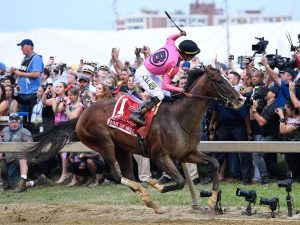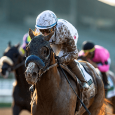Preakness Stakes Winners

War of Will wins the Preakness Stakes – US Racing Photo
The Preakness is unique among the three races in that it requires three specific things — a painter, access to a rainbow of paint colors and a hydraulic lift ready for a soon as the race’s winner crosses the finish line.
Each year, the silks belonging to the winner of the Preakness Stakes are painted on the jockey located on top of a weathervane sitting above a replica of the track’s Old Clubhouse cupola. The painter also includes the numbers on the horse’s saddlecloth. The paint job remains for a calendar year until the next year’s Preakness, except for this year as the race was delayed six months thanks to the Covid-19 pandemic.
The painting of the weathervane tradition practice began at Pimlico in 1909 at Pimlico on the the old Members’ Clubhouse. The Victorian building was destroyed by fire in June of 1966, but a replica of the old building’s cupola was built to stand in the Preakness winners’ circle in the infield.
RELATED: Preakness Stakes 2020 Odds: Robby Albarado Seeks Elusive Spotlight With Swiss Skydiver
The original building had an arrow-shaped weather vane, but in 1909 it was struck down by lightning and the Maryland Jockey Club commissioned an ornamental ironworker to forge a new weathervane in the form of a horse and rider. The first silks to adorn the new weathervane was 1909 winner Effendi and his jockey, Willie Doyle. In 1918, when the Preakness was run in two divisions the winning colors were changed between Jack Hare Jr. and War Cloud after the first six months. When the old Members’ Clubhouse burned down the only thing saved from the ruins was the iron weathervane and it is currently on display at Pimlico’s museum exhibit, “Hoofbeats Through History.”
Lawrence Jones, who lives in the Pimlico neighborhood, is the name of the man who currently holds the job as the weathervane painter. In 2000, Jones was joined by a special partner to carry out the tradition following Preakness 125 as renowned artist LeRoy Neiman applied the winning colors along with Jones following the classic race.
Preakness Stakes Black-Eyed Susans History
Each year, the winner of the Preakness is adorned with a blanket of Black-Eyed Susans across the withers and in front of the jockey. In 1940 Colonel Edward R. Bradley’s
The Black-Eyed Susan blanket is created shortly before Preakness Day and it takes about eight hours for four people to construct it. It’s made up of black matting, a layer of green felt, a layer of a variety of Ruscus and then a layer of Viking Poms, which is a substitute for actual Black-Eyed Susans, which bloom usually after the Preakness is run from June through October.
Two people cut Viking Poms, which is a variety of a daisy, about an inch from the flower and insert a wire into each stem. Two others then attach each flower through the matting by poking a wire through the actual flower in order to secure it to the matting. The process is repeated 4,000 times until the matting is completely covered. The green felt is then is sewn by hand to the back of the matting so that the wires are protected from touching the horse.
The blanket of Black-Eyed Susans is 18 inches wide and 90 inches in length. The center each Viking Pom are daubed with black lacquer to recreate the appearance of a Black-Eyed Susan. The blanket is then sprayed with water to keep it as fresh as possible and refrigerated until Preakness Day, when it is delivered to the track,
Black-Eyed Susans were declared the state flower by the Maryland legislature in 1918 and the official flower of the Preakness in 1940. The legend surrounding the Black-Eyed Susans is said to be that the usual number of 13 petals symbolizes the 13 original colonies, of which Maryland was one, and the flower itself represents the state’s black and yellow colors.
RELATED: Odds & Ends: Belmont Preview; Midnight Bisou, Saudi Cup, Canadian Triple Crown, L’Arc



